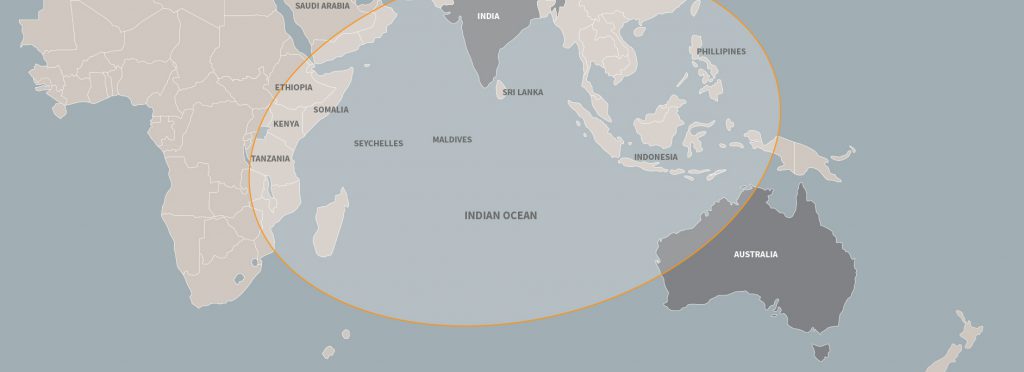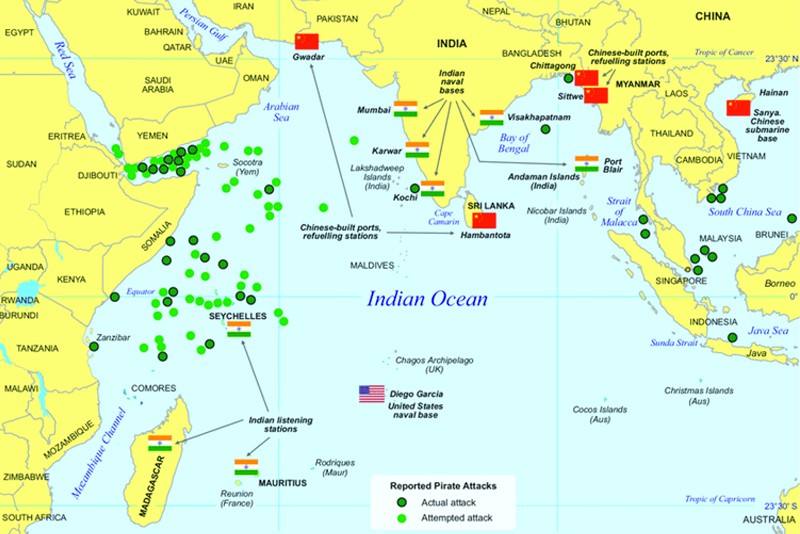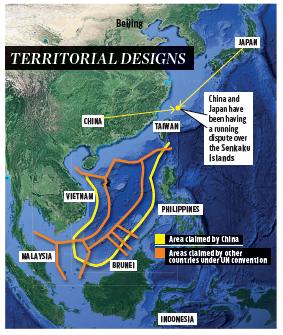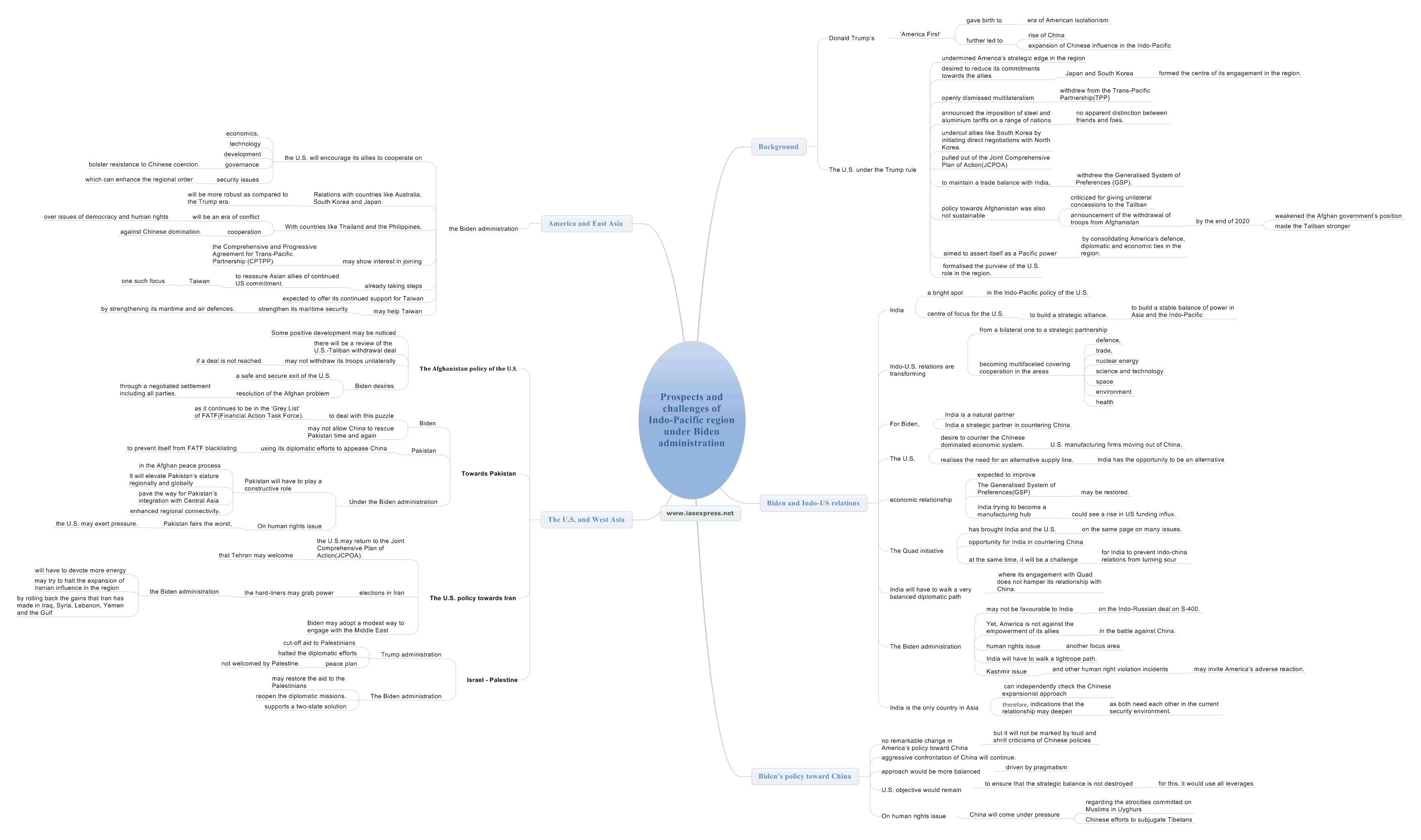[Updated] Strategic Significance of Indo-Pacific

From Current Affairs Notes for UPSC » Editorials & In-depths » This topic
IAS EXPRESS Vs UPSC Prelims 2024: 85+ questions reflected
The term ‘Indo-Pacific’ is used to denote America’s new geopolitical view of Asia. For the U.S. administration, the policy for Indo-Pacific is key to its maintenance of supremacy in the global order. As Joe Biden assumes the presidential office of the U.S., there are varied implications for the whole world of which the Indo-Pacific region remains to be one of the main focuses. Biden claimed that “America is back” and suggested “major shifts” in approach regarding foreign policy issues. The U.S. appears to remain in the game of Indo-Pacific for a longer time. America’s policy towards the countries like India, China and Southeast Asian nations will be a decisive factor in determining the prospects and challenges of the Indo-Pacific region. Under the Biden administration, the U.S. is expected to have a robust military presence in the Indo-Pacific region and at the same time, it has pledged to have deeper ties with the nations in the region. Hence, it will be one of the major players in the geopolitical atmosphere of the region. Thus, it has become important for the Indo-Pacific regional nations to weigh in their prospects and challenges in the given situation to draw the best out of it.
What is Indo-Pacific?
- The term, in the contemporary context of security, was first used by Gurpreet Khurana in 2007 in the article “Security of Sea Lines: prospects for India-Japan cooperation” of Strategic Analysis journal.
- According to this article, Indo-Pacific is the maritime space stretching from East Africa and West Asia’s littoral countries, across the Indian Ocean and the western Pacific Ocean to East Asia’s littoral countries.
- Japanese Prime Minister Shinzo Abe later used it in his speech in the Indian Parliament to signify the confluence of the Indian and Pacific Oceans.
- In 2013, the US began using Indo-Asia Pacific to enable the security inclusiveness of the Indo-Pacific region.
Why is the Indo-Pacific region important?
- It is a region that is rich with natural resources like mineral resources and fishes.
- It consists of the Strait of Malacca, Sunda Strait and Lombok Strait – routes that are vital for global trade.
- It consists of the South China Sea which is located in the Central Indo-Pacific region.
What is the strategic significance of the South China Sea?
- Some of the rich economies like Japan, the US, China, ASEAN countries are dependent on South China Sea route for trade and market access.
- About $3.5 trillion worth of international trade is dependent on the South China Sea.
- It is crucial as it is the second most used sea lane in the world.
- A report released by the US Energy Information Administration in 2013 estimated that the South China Sea may have a total of 11 billion barrels of oil reserve.
- According to a study by the Philippines’s Department of Environment and Natural Resources, the South China Sea has one-third of the entire world’s marine biodiversity.
- It is crucial for the food security of many Southeast Asian countries.
- With its huge reserve of resources, the South China Sea, the part of the Indo-Pacific region has crucial strategic significance.
What is the issue in the South China Sea?
- Several countries have territorial disputes over the South China Sea.
- However, the People’s Republic of China has dominated the whole issue.
- China claims that entire South China is its sovereign territory as it has historical links to this region.
- China also claims that it has all the rights to decide security measures and create artificial islands within the South China Sea.
- The International Court of Arbitration had officially rejected this claim in 2016.
- Also, China refused to abide by the UN Convention for the Law of Sea (UNCLOS) as it claims the whole of the South China Sea to be part of its territory.
- To officially claim its sovereignty over the South China Sea, China had established an oil rig near the Paracel Islands in 2014.
- In May 2017, China announced that it was able to mine methane clathrate – the future hydrocarbon source, from the South China Sea.
- It is also conducting various naval exercises to intimidate the smaller and weaker South East Asian countries.
What are the South East Asian countries doing about it?
- ASEAN countries, especially Malaysia are not willing to escalate the conflict in the South China Sea.
- Both China and Vietnam have signed an agreement to deescalate the dispute over the South China Sea.
- Shortly after this, India’s state-run ONGC had signed MoU with PetroVietnam for long term cooperation in the oil sector.
- Fishes have depleted in this region. The countries used this to claim their territory by banning fishing in the disputed areas.
- Indonesian authorities took down Vietnamese fishing fleets for breaching Indonesia’s disputed maritime territories.
- The Philippines sued China in the International Court of Arbitration in 2016.
- However, in recent times, the Philippines are willing to give away its territories for Chinese investments.
- From this, it is evident that the South East Asian countries are neither strong enough nor are they willing to confront China’s coercive expansionist policies.
- Many are members of the BRI – China’s multi-billion project to connect Africa, Asia and Europe through the ancient routes of the Silk Road.
Why is this region important to India?
- About 50% of India’s trade is dependent on the South China Sea route.
- ONGC Videsh Ltd, a public sector enterprise of the Central Government of India is currently searching for oil and gas in the Exclusive Economic Zone of Vietnam.
- About 82% of India is dependent on oil imports.
- Hence, the South China Sea is vital for the Indian Economy.
What is India’s role in this issue?
- India is advocating for a free and open Indo-Pacific.
- India is a part of the prestigious Malabar Exercise since 1992.
- It was initially a bilateral naval exercise between India and the US.
- In 2015, Japan joined this naval activity to counter China’s dominance in this region.
- Currently, Japan is calling for reinitiating the QUAD – the informal strategic dialogue between the US, Japan, India and Australia that aims to construct measures to safeguard the Indo-Pacific region from Chinese dominance.
- However, due to Australia’s close ties with China, India has declined Australia’s inclusion in the Malabar Excise.
- Australia had initially pulled out of QUAD. However, it has re-entered in 2017 by meeting the other three counties in the 2017 ASEAN summit to retrieve the QUAD.
Way Forward:
- For India to progress, it is vital to increase its presence across the globe.
- This means that India must take measure to forge an alliance with its neighbours as well as the other friendly countries.
- However, it is also essential for India to safeguard its own strategic priorities before indulging in large scale military exercises.
- Also, it is vital for the South East Asian countries to resolve their issues amicably to counter China’s coercive military measures in the South China Sea.
What is the Senkaku Islands dispute?*
- The Senkaku Islands are a cluster of uninhabited islands- a part of the Ryukyu Islands– in the East China Sea. It is known as the Diaoyu Islands by the Chinese and as Diaoyutai Islands by the Taiwanese.
- These islands, presently under Japanese administration, are disputed among China, Taiwan and Japan.
- The island chain is situated roughly in the centre of the sea separating the 3 countries.
History of the dispute
- The islands were formally claimed, in 1895, by Japan.
- The USA took over control of these islands after Japan’s defeat during World War II.
- In 1971, the island chain was returned to Japan, which has been administering the islands to date.
- In the 1970s, China began staking claims to the islands, citing historical rights. The Taiwan government also laid claims around this period. China and Taiwan consider the Senkakus as a part of the erstwhile Formosa.
- However, the claims came in following the discovery of potential natural gas reserves in the region.
- Japan does not recognize the claims of China.
- Previously, the islands were owned by a private Japanese citizen. They were purchased by the Japanese government in 2012 and made a part of Okinawa Prefecture.
Geopolitical value of the islands
- The islands attracted the attention of the disputing states, in the 1970s, due for 2 reasons:
- The possible presence of natural resources: According to a 1969 ECAFE (the United Nations Economic Commission for Asia and the Far East) report, there are possibly huge reserves of oil and natural gas in the area- especially north of Taiwan in a 200,000 square kilometre stretch. These are also valuable fishing grounds (the Chinese name Diaoyu Dai means ‘fishing platform’) for the states. Whichever state enjoys sovereignty over the Senkakus will hold the right to exploit these natural resources.
- Security concerns: whichever state holds control over the Senkakus would hold significant advantages if a military situation is to arise. The state would be able to restrict not only naval vessels in the surrounding EEZ (Exclusive Economic Zone) but also research/ shipping vessels and even aircraft.
Recent disputes
- Recently, the Chinese have been increasing their presence in the area surrounding the Senkaku Islands. In the last year itself, they have committed over 600 transgressions.
- This comes after a city assembly in Okinawa Prefecture of Japan passed a resolution to rename the administrative area in which the Senkakus fall.
- This change of name from “Tonoshiro” to “Tonoshiro Senkaku” drew sharp criticism from Beijing which perceives the move as a ‘serious challenge to its territorial sovereignty. The renaming is to take effect in October.
- In the aftermath of the resolution, Chinese Coast Guard ships have been in the area around the Senkakus for 80 days in a row- the longest streak since 2012.
- Japan protested with the Chinese government through diplomatic channels. It also protested Beijing recently renaming sea beds in the East China Sea region, including the Senkaku region.
- This signals rising tensions between the 2 countries. The Senkaku Islands has become a flashpoint in the Indo-Pacific region.
Significance and implications
- This is just the latest addition to examples of China’s increasing assertiveness and aggressive pursuit of becoming a regional hegemony. This move is being seen as China turning the COVID-19 crisis into an opportunity.
- Economically, China has a high dependence on the high seas- as much as 40% of its GDP is dependent on it. It is expected that China will only be resorting to such actions more frequently.
- Domestic criticism in China against Japan also plays a role in the dispute. China has been historical rivals to Japan- their relation being compared to the UK- France rivalry in Europe.
- Japan too is changing in various ways. It has increased its defence spending from 1% of GDP to more than 2.5% of GDP. However, it is also facing its own domestic issues- it has one of the slowest economic growth rates among the developed nations, it has a fast ageing population, etc.
- The USA has been stepping up its presence in the South China Sea recently- with as many as 3 aircraft carriers deployed here much to China’s ire. This is also being seen as a trigger for the suddenly increased assertiveness of China. However, the USA’s actions are being seen by experts as a move to prevent China’s expansion into the Pacific rather than to safeguard the small Asian countries from Chinese dominance. This is evident from the USA charging more and more for its security services to countries like Japan.
- Finally, experts have noted a differential approach adopted by China when it comes to expanding in the East China Sea than in the South China Sea. The South China Sea already has a dominant physical presence and is hence resorting to what is called the ‘Salami Slicing Strategy’ by establishing artificial islands, naval bases, etc. In the case of the East China Sea, it is using ‘Incremental Expansionism’ to increase its legitimacy in regions where it doesn’t have a dominant presence. This is by increasing its duration of presence in the seas- as in the recent case.
Prospects and challenges of Indo-Pacific region under Biden administration
Background
- Donald Trump’s ‘America First’ policy gave birth to the era of American isolationism which further led to the rise of China and expansion of its influence in the Indo-Pacific region through its various efforts like the Belt and Road Initiative(BRI), etc.
- The U.S. under the Trump rule also undermined America’s strategic edge in the region. The U.S. desired to reduce its commitments towards the allies like Japan and South Korea which formed the centre of its engagement in the region.
- The U.S. under the Trump administration also openly dismissed multilateralism and withdrew from the Trans-Pacific Partnership(TPP).
- The Trump administration also announced the imposition of steel and aluminium tariffs on a range of nations—including China, Japan, Australia and Taiwan in the region—with no apparent distinction between friends and foes.
- The U.S also undercut allies like South Korea by initiating direct negotiations with North Korea.
- The U.S. pulled out of the Joint Comprehensive Plan of Action(JCPOA) with Iran. JCPOA is an Obama-era nuclear agreement to restrain Iran from enriching its nuclear capabilities in exchange for relief from sanctions.
- The Trump administration to maintain a trade balance with India, withdrew the Generalised System of Preferences (GSP).
- The American policy towards Afghanistan was also not sustainable. The Trump administration was criticized for giving unilateral concessions to the Taliban. Trump’s announcement of the withdrawal of troops from Afghanistan by the end of 2020 weakened the Afghan government’s position and made the Taliban stronger.
- At the same time, the U.S. aimed to assert itself as a Pacific power by consolidating America’s defence, diplomatic and economic ties in the region.
- In short, the Trump administration formalised the purview of the U.S. role in the region.
Biden and Indo-US relations
- India has been a bright spot in the Indo-Pacific policy of the U.S. As the U.S. faces a set of diverse challenges, to build a stable balance of power in Asia and the Indo-Pacific region, India will be the centre of focus for the U.S. to build a strategic alliance.
- Indo-U.S. relations are transforming from a bilateral one to a strategic partnership. The relationship is becoming multifaceted covering cooperation in the areas starting from defence, trade, nuclear energy, science and technology to space, environment and health. For Biden, India is a natural partner. In addition to this, the Biden government considers India a strategic partner in countering China.
- The U.S. has a desire to counter the Chinese dominated economic system. With U.S. manufacturing firms moving out of China, the U.S. realises the need for an alternative supply line. Here, India has the opportunity to be an alternative.
- Under the Biden administration, the economic relationship between India and the U.S. is expected to improve. The Generalised System of Preferences(GSP) may be restored. There may be a significant improvement in economic relations with India trying to become a manufacturing hub that could see a rise in US funding influx.
- The Quad initiative involving countries like India, Australia, Japan and the U.S. which has the support of most of the ASEAN countries has brought India and the U.S. on the same page on many issues. The Quad dialogue can be seen as an opportunity for India in countering China and at the same time, it will be a challenge for India to prevent Indo-china relations from turning sour after the recent disengagement at the Indo-China border. India will have to walk a very balanced diplomatic path where its engagement with Quad does not hamper its relationship with China.
- The Biden administration may not be favourable to India on the Indo-Russian deal on S-400. Yet, America is not against the empowerment of its allies in the battle against China. Therefore, it will be important to see how the U.S. under Biden rule deals with Indo-Russia relations.
- The human rights issue is another focus area of the Biden administration. Here, India will have to walk a tightrope path. The Kashmir issue and other human right violation incidents may invite America’s adverse reaction.
- On the whole, there will be no fundamental change in America’s stance toward India including major issues concerning Indo-Pacific. U.S. concerns about countering China, which directly affects the U.S. global role require closer strategic ties with India. India is the only country in Asia, which can independently check the Chinese expansionist approach. There are indications that the relationship may deepen in the coming years as both need each other in the current security environment.
Biden’s policy towards China
- There will be no remarkable change in America’s policy toward China but it will not be marked by loud and shrill criticisms of Chinese policies as it was during the Trump era. The aggressive confrontation of China will continue.
- Biden administration’s approach would be more balanced driven by pragmatism. The U.S. objective would remain to ensure that the strategic balance is not destroyed by China and for this, it would use all leverages.
- On human rights issue, China will come under pressure regarding the atrocities committed by Muslims in Uyghurs and Chinese efforts to subjugate Tibetans by destroying their culture and religion and imposing the CCP’s ideology.
The U.S. and West Asia
- The Afghanistan policy of the U.S. – Some positive development on the Afghan issue may be noticed. As the U.S. is set to pull out of Afghanistan, there will be a review of the U.S.-Taliban withdrawal deal. The Biden administration may not withdraw its troops unilaterally if a deal is not reached. Biden desires a safe and secure exit of the U.S. and the resolution of the Afghan problem through a negotiated settlement including all parties.
- Towards Pakistan – Biden has to deal with this puzzle as it continues to be in the ‘Grey List’ of FATF(Financial Action Task Force). Pakistan is using its diplomatic efforts to appease China to prevent itself from FATF blacklisting. Biden may not allow China to rescue Pakistan time and again as it will signify America’s re-embrace of multilateralism as a mere show off which has less to do with rule-of-law and international security. Under the Biden administration, Pakistan will have to play a constructive role in the Afghan peace process. Afghanistan’s neighbours will still need to be on board. It will elevate Pakistan’s stature regionally and globally and will also pave the way for Pakistan’s integration with Central Asia and enhanced regional connectivity. On human rights issue where Pakistan fairs the worst, the U.S. may exert pressure.
- The U.S. policy towards Iran – Under the Biden administration, the U.S. may return to the Joint Comprehensive Plan of Action(JCPOA). There is a possibility that Tehran will welcome the U.S. move. At the same time, there are elections in Iran in June 2021 that may lead to the change in those who are in power. There is a huge possibility that the hard-liners may grab power this time. Given this case, the Biden administration will have to devote more energy to employ differing but complementary short term and long-term approaches to maintain the security of the region. Biden may try to halt the expansion of Iranian influence in the region by rolling back the gains that Iran has made in Iraq, Syria, Lebanon, Yemen and the Gulf. To sum up, Biden may adopt a modest way to engage with the Middle East.
- Israel – Palestine – The Trump administration cut-off aid to Palestinians and halted the diplomatic efforts. The peace plan envisaged by Trump which recognised Israeli sovereignty over Jewish settlements in the occupied West Bank and Jordan Valley, and Jerusalem remaining Israel’s “undivided capital” was not welcomed by Palestine. The Biden administration may restore the aid to the Palestinians and reopen the diplomatic missions. Mr Biden supports a two-state solution to the Israeli-Palestinian conflict that may bring the peace process to its destination.
America and East Asia
- Under the Biden administration, the U.S. will encourage its allies to cooperate on economics, technology, development, governance and security issues which can enhance the regional order and bolster resistance to Chinese coercion.
- Relations with countries like Australia, South Korea and Japan will be more robust as compared to the Trump era. With countries like Thailand and the Philippines, it will be an era of conflict over issues of democracy and human rights and cooperation against Chinese domination.
- The Biden administration may show interest in joining the Comprehensive and Progressive Agreement for Trans-Pacific Partnership (CPTPP).
- The Biden administration is already taking steps to reassure Asian allies of continued US commitment. Taiwan is one such focus. The U.S. is expected to offer its continued support for Taiwan. The U.S. may help Taiwan strengthen its maritime security by strengthening its maritime and air defences.
Conclusion
The Indo-Pacific, with its wealth of natural resources and strategic significance, is bound to create conflicts among nations. Ensuring multilateralism is vital for international peace and optimum use of the limited resources available in the region. The Biden administration will continue to give the Indo-Pacific a significant priority. The U.S. Indo-Pacific policy can be expected to reach beyond the defence and security concerns that have been the overwhelming focus of the Trump administration. Questions of governance and regional diplomacy will receive increased focus. The question remains whether the U.S. will be able to deter Chinese domination in the region given its military commitments towards West Asia and Europe. The U.S. may find it difficult to maintain the military balance. The region has opportunities as well as challenges to deal with under the Biden administration. Only time will tell whether the prospects will outweigh the challenges or vice versa will happen.
Practice question for mains
1.With reference to the recent Senkaku Islands dispute, discuss the reasons for continued territorial disputes in the Indo-Pacific region. (250 words)
2. Comment on the prospects and challenges of the Indo-Pacific region under the Biden administration giving special attention to implications for India. (250 words)
If you like this post, please share your feedback in the comments section below so that we will upload more posts like this.







